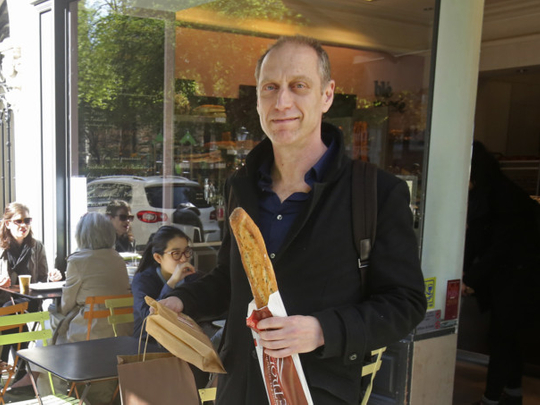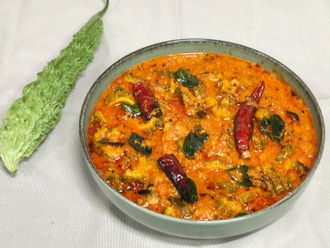
David Lebovitz snaps a photo of a practically perfect croissant before taking a bite, then smiling slightly.
He’ll probably be asked for the recipe later, though he did not bake the croissant, nor was it made in his kitchen. But after six cookbooks, more than 27,000 tweets and a food website dating to the early years of html, readers expect recipes to go with the photos of Parisian food most can only crave from a distance.
Lebovitz spent 13 years as a chef at Alice Waters’ Chez Panisse, quit to write books in 1999, and then moved to Paris in 2004 without a plan.
“I thought, may be I’ll move to Paris because I can write there,” he said in a recent interview after ruefully acknowledging his lack of a dramatic backstory.
A decade later, he has no intention of opening his own restaurant or bakery — France’s bureaucracy is daunting even for natives.
“All the rumours you hear about French paperwork are true. I love cooking and I love baking but owning a business is probably 10 per cent cooking and baking and 90 per cent paperwork and bureaucracy,” he said. “I decided to take a pass.”
His latest book, My Paris Kitchen, feeds into the desire to cook, shop and eat in the city that prides itself on being the culinary centre of the world. Half cookbook, half musings on everything from line etiquette (watch out for unexpectedly tough little old ladies) to the acronym-filled documentation that floods every French household (going paperless is a distant dream).
Though practically none of Lebovitz’s readers have tasted his food, he has a vicarious following all his own. And his readers — more than a third are from outside America — don’t hesitate to tell him when they think a photo is blurry, a recipe seems off or his take on barbecue is out of line.
“One of the reasons I started my website in 1999 was I wanted people to be able to get in touch with me after my first cookbook. From that ‘What was I thinking?’ file,” he said. “It’s what the web is all about. It’s an interaction of ideas.”
Being a cookbook author is something of a strange calling, especially in a city where the average apartment is roughly one-third the size of an American home. It meant that the renovation of Lebovitz’s kitchen — the room he considers his office — took on outsized drama, especially when his manuscript disappeared in the disorder.
“I have two ovens. I have the largest refrigerator in Paris — that’s my desk,” he said, seated at a café table outside his favourite bakery. Every few minutes someone would stop to greet him, a sign of neighbourhood integration hard-won in reserved Paris.
France has changed his cooking in surprising ways.
“I started relying on things you can buy. Americans are into this whole DIY thing, but in France if you want a pâte you go to the charcuterie and there are like 15 kinds of amazing pate,” he said.
And, though My Paris Kitchen is filled with accessible recipes that reflect how Lebovitz cooks at home, he said when he cooks for French friends, he tends towards Mexican — and he tries to counter his native country’s reputation for indifference towards food.
“The image of that is changing,” he said. “People used to think all Americans ate at McDonalds because that’s all they saw.”
FATTOUSH
“I love nothing more than a big bowl heaped with salads of all kinds, especially one dressed with a pungent lemony garlic dressing and a jumble of ingredients,” Lebovitz writes in his new cookbook, My Paris Kitchen. “And one of the most interesting salads is fattoush, a Middle Eastern dish that’s sprinkled with ground sumac, a powder that’s both a little fruity and a little tart, and tossed with fatteh, the Arabic word for shards of toasted pita bread, which gives the salad its name.”
Time: 30 minutes
6 servings
Ingredients
2 large or 4 small rounds of pita bread
1/2 cup olive oil, plus extra for brushing the pita
1/3 cup lemon juice
1 tsp sea salt
2 cloves garlic, peeled and minced
1 tsp Dijon mustard
8 cups torn or wide-cut ribbons of romaine lettuce
4 scallions, white and tender green parts, thinly sliced
1 cucumber, peeled, seeded and cut into large dice
20 cherry tomatoes, halved
1/2 cup coarsely chopped fresh flat-leaf parsley
1/2 cup coarsely chopped fresh mint
1/2 bunch radishes, thinly sliced
1 1/2 tsp ground sumac
Ground black pepper
Steps
Heat the oven to 176C. Put the pita breads on a baking sheet, brush them evenly with olive oil, then toast for 10 to 12 minutes, or until crisp. Remove from the oven and let cool completely.
In a large serving bowl, whisk together the lemon juice, salt, garlic and mustard. Whisk in the 1/2 cup of olive oil.
Add the lettuce, scallions, cucumber, tomatoes, parsley, mint and radishes. Toss the salad with 1 tsp of the sumac and a few generous grinds of pepper. Crumble the pita into irregular pieces that are slightly larger than bite-size and gently toss until the pieces of pita are coated with the dressing. Sprinkle the salad with the remaining 1/2 tsp of sumac and serve.
Nutrition information per serving: 320 calories; 230 calories from fat (72 per cent of total calories); 25g fat (3.5g saturated; 0g trans fats); 0mg cholesterol; 21g carbohydrate; 3g fibre; 5g sugar; 4g protein; 470mg sodium.
















